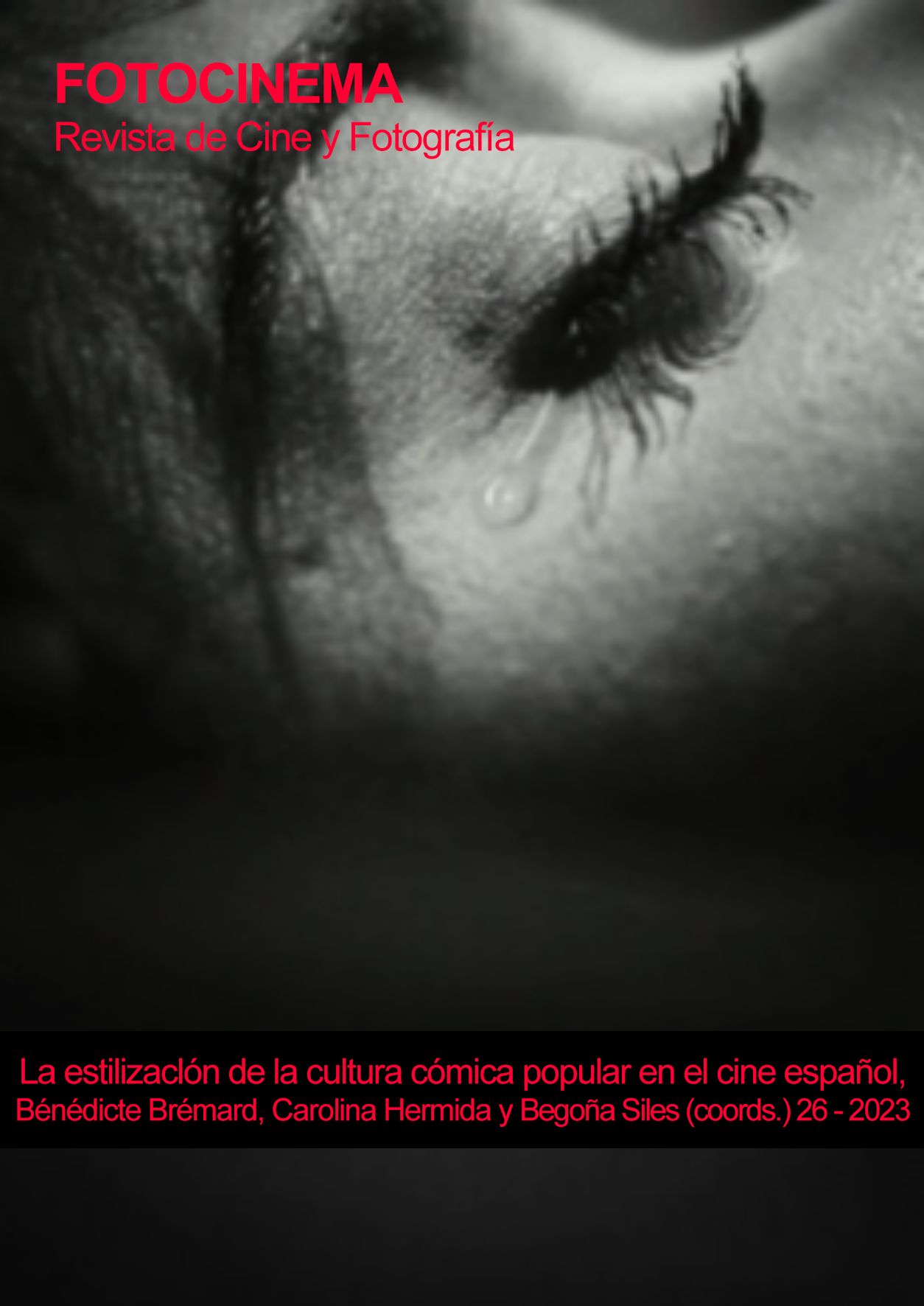The astracán (Spanish theatrical parody) and the grotesque in Pedro Almododar’s comedy
DOI:
https://doi.org/10.24310/Fotocinema.2023.vi26.15517Keywords:
Almodóvar Pedro, comedy films, astracán, grotesque, postmodernityAbstract
This work analyzes the presence of the astracán and the grotesque in Pedro Almodóvar's cinema, specifically, not only in those films classified as comedies —Pepi, Luci, Bom and other girls like Mom (1980), Women on the verge of a nervous breakdown (1988) and I’m so excited! (2013)—, but also in those comical situations that the author introduces in the most melodramatic plots when he inserts eccentric characters or ludicrous dialogues. It is a question, then, of verifying to what extent the Almodovarian aesthetic, which is situated in a specific current (postmodern cinema), has its origin in aesthetic forms of the Spanish literary tradition and allows him to develop models of artistic expression which are cut off from reality and in which he identifies cinema with representation to thus reinforce the pact of fiction with the viewer.
Downloads
Metrics
Publication Facts
Reviewer profiles N/A
Author statements
Indexed in
-
—
- Academic society
- N/A
- Publisher
- Universidad de Málaga
References
Almodóvar, P. (1991): Patty Diphusa y otros textos. Barcelona: Anagrama.
Amaya Flores, F. J. (2022) “La teatralidad como pacto de ficción en La voz humana de Pedro Almodóvar” en Tropelías, nº 37, pp. 59-71 (en línea: https://papiro.unizar.es/ojs/index.php/tropelias/article/view/6084, consulta: 15 de septiembre de 2022.
Fauconnier, D. (2005): “Lo grotesco en el cine de Almodóvar”, en Zurián, F. A. y Vázquez Varela, C. (comps.), Almodóvar. El cine como pasión. Cuenca: Universidad de Castilla-La Mancha, pp. 195-206.
Forgione, A. P. (2005): “Pedro Almodóvar y el esperpento: hacia una nueva retórica de la imagen”, en Zurián, F. A. y Vázquez Varela, C. (comps.), Almodóvar. El cine como pasión. Cuenca: Universidad de Castilla-La Mancha, pp. 207-228.
Fuente Ballesteros, R. de la (1985): “En torno al ‘Astracán’”, en Castilla: Estudios de Literatura, pp. 23-44.
Gubern, R. (2005): “Las matrices culturales de la obra de Almodóvar”, en Zurián, F. A. y Vázquez Varela, C. (comps.), Almodóvar. El cine como pasión. Cuenca: Universidad de Castilla-La Mancha, pp. 45-56.
Lugo, M. D. (2005): “Genealogía de las ‘sórdidas comedias neorrealistas’ almodovarianas”, en Zurián, F. A. y Vázquez Varela, C. (comps.), Almodóvar. El cine como pasión. Cuenca: Universidad de Castilla-La Mancha, pp. 81-92.
Mihura, M. (2004): Teatro completo. Edición, introducción y notas de Arturo Ramoneda. Navarra: Cátedra.
Pérez Ayala, R. (1924): Las máscaras. Madrid: Renacimiento, tomo II.
Pérez Perucha, J. (1998): “Territorios de encrucijada”, Wenceslao Fernández Flores y el cine español, 3º Festival Internacional de Cine Independiente Ourense. Ourense: Foro Cinematográfico do Eixo Antlántico, pp. 51-60.
Ramos, V. (1966): Vida y teatro de Carlos Arniches. Madrid: Alfaguara.
Ríos Carratalá, J. A. (2007): “El verdugo y la tragedia grotesca”, en ALEUA: Anales de Literatura Española, 19, pp. 219-235.
Rodríguez, J.C. (2001): La literatura del pobre. Granada: de guante blanco/ Comares.
Sánchez Noriega, J. L. (2017): Universo Almodóvar. Estética de la pasión en un cineasta posmoderno. Madrid: Alianza Editorial.
Sánchez, Sánchez, J.P. (2006): “La señorita de Trevélez: tragedia grotesca de Carlos Arniches”, en Revista de Filología. La Laguna, pp. 225-236.
Torre-Espinosa, M. de la (2020): Almodóvar y la cultura. Del tardofranquismo a la Movida. Asturias: Trea.
Valle-Inclán, R. M. (1996): Luces de bohemia. Esperpento. Madrid: Espasa Calpe. Col. Austral teatro.
Valle-Inclán, R. M. (2001): Martes de carnaval. Esperpentos. Madrid: Espasa Calpe. Col. Austral teatro
Zamora Vicente, A. (1988): “Prólogo”, en Luces de Bohemia. Madrid: Alianza Editorial
Zunzunegui, S. (2018): Historias de España. De qué hablamos cuando hablamos de cine español. Cantabria: shangrila
Downloads
Published
How to Cite
Issue
Section
License
All contents published in Fotocinema Revista científica de cine y fotografía are protected under the Creative Commons Attribution-NonCommercial-ShareAlike 4.0 International (CC BY-NC-SA 4.0) license. All about this license is available in the following link: <http://creativecommons.org/licenses/by-nc-sa/4.0>
Users can copy, use, redistribute, share and exhibit publicly as long as:
- The original source and authorship of the material are cited (Journal, Publisher and URL of the work).
- It is not used for comercial purposes.
- The existence of the license and its especifications are mentioned.
There are two sets of authors’ rights: moral and property rights. Moral rights are perpetual prerogatives, unrenounceable, not-transferable, unalienable, imprescriptible and inembargable. According to authors’ rights legislation, Fotocinema. Revista científica de cine y fotografía recognizes and respects authors moral rights, as well as the ownership of property rights, which will be transferred to University of Malaga in open access. The property rights are referred to the benefits that are gained by the use or the dissemination of works. Fotocinema. Revista científica de cine y fotografía is published in an open access form and it is exclusively licenced by any means for doing or authorising distribution, dissemination, reproduction, , adaptation, translation or arrangement of works.
Authors are responsable for obtaining the necessary permission to use copyrighted images.














13.png)



